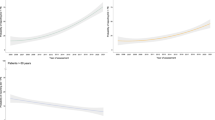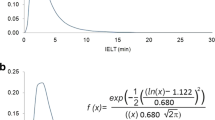Abstract
Although both biological and psychological factors are important in the etiology, the exact pathogenesis of lifelong premature ejaculation (PE) remains to be clarified. Obesity is a worldwide epidemic that contributes to many chronic diseases. Obesity is associated with erectile dysfunction, but the relationship between obesity and PE has not yet been specifically investigated. The aim of this study was to evaluate the relationships of these two conditions. Between January 2008 and December 2009, we evaluated consecutive patients with lifelong PE in the urology outpatient clinic. Control cases without lifelong PE were selected randomly among cases attending the department of internal medicine for a checkup procedure. The age and sex of control group were matched with that of the study group. Body mass index (BMI) of each case was calculated using the World Health Organization criteria by the measurements of the physician instead of relying on verbal expressions. The mean (±s.d.) age of the premature ejaculators was 31.7±5.7 (range 21–51) years and in the control cases it was 32.3±6.7 (range 22–54) years. The comparison of the mean (±s.d.) weight between the study (74.1±11.2 kg) and control groups (81.9±6.4 kg) revealed a significant difference (P<0.001). The mean BMI of premature ejaculators (24.9±3.4 kg m–2) was lower than the mean BMI of control (27.5±3.6 kg m–2; P<0.001). As the BMI increased, the number of patients decreased in the PE group. The number of the obese cases in the control group (n=26, 24.1%) was three times greater than the obese premature ejaculators (P<0.005), and the number of PE patients were approximately two times greater than the control cases in the normal-weight class (P<0.001). This is the first prospective study that investigated the relationship between lifelong PE and obesity, and we found that patients with lifelong PE were leaner than the healthy control cases.
This is a preview of subscription content, access via your institution
Access options
Subscribe to this journal
Receive 8 print issues and online access
$259.00 per year
only $32.38 per issue
Buy this article
- Purchase on Springer Link
- Instant access to full article PDF
Prices may be subject to local taxes which are calculated during checkout
Similar content being viewed by others
References
Cameron AJ, Shaw JE, Zimmet PZ . The metabolic syndrome: prevalence in worldwide populations. Endocrinol Metab Clin North Am 2004; 33: 351–375.
Must A, Spadano J, Coakley EH, Field AE, Colditz G, Dietz WH . The disease burden associated with overweight and obesity. JAMA 1999; 282: 1523–1529.
Eckel RH, Grundy SM, Zimmet PZ . The metabolic syndrome. Lancet 2005; 365: 1415–1428.
Kahn R, Buse J, Ferrannini E, Stern M . The metabolic syndrome: time for a critical appraisal: joint statement from the American Diabetes Association and the European Association for the Study of Diabetes. Diabetes Care 2005; 28: 2289–2304.
Jannini EA, Lenzi A . Ejaculatory disorders: epidemiology and current approaches to definition, classification and subtyping. World J Urol 2005; 23: 68–75.
Althof S, Rosen R, Symonds T, Mundayat R, May K, Abraham L . Development and validation of a new questionnaire to assess sexual satisfaction, control, and distress associated with premature ejaculation. J Sex Med 2006; 3: 465–475.
McMahon CG, Althof SE, Waldinger MD, Porst H, Dean J, Sharlip ID et al. An evidence-based definition of lifelong premature ejaculation: report of the International Society for Sexual Medicine (ISSM) ad hoc committee for the definition of premature ejaculation. J Sex Med 2008; 5: 1590–1606.
Cooper AJ, Cernovsky ZZ, Colussi K . Some clinical and psychometric characteristics of primary and secondary premature ejaculators. J Sex Marital Ther 1993; 19: 276–288.
Esposito K, Giugliano F, Ciotola M, De Sio M, D’Armiento M, Giugliano D . Obesity and sexual dysfunction, male and female. Int J Impot Res 2008; 20: 358–365.
Kupelian V, Shabsigh R, Araujo AB, O’Donnell AB, McKinlay JB . Erectile dysfunction as a predictor of the metabolic syndrome in aging men: results from the Massachusetts Male Aging Study. J Urol 2006; 176: 222–226.
Allison DB, Saunders SE . Obesity in North America. An overview. Med Clin North Am 2000; 84: 305–332.
Coolen LM, Allard J, Truitt WA, McKenna KE . Central regulation of ejaculation. Physiol Behav 2004; 83: 203–215.
Corona G, Jannini EA, Mannucci E, Fisher AD, Lotti F, Petrone L et al. Different testosterone levels are associated with ejaculatory dysfunction. J Sex Med 2008; 5: 1991–1998.
Keleta YB, Lumia AR, Anderson GM, McGinnis MY . Behavioral effects of pubertal anabolic androgenic steroid exposure in male rats with low serotonin. Brain Res 2007; 1132: 129–138.
Hammoud AO, Gibson M, Peterson CM, Meikle AW, Carrell DT . Impact of male obesity on infertility: a critical review of the current literature. Fertil Steril 2008; 90: 897–904.
Giagulli VA, Kaufman JM, Vermeulen A . Pathogenesis of the decreased androgen levels in obese men. J Clin Endocrinol Metab 1994; 79: 997–1000.
Tchernof A, Despres JP, Belanger A, Dupont A, Prud’homme D, Moorjani S et al. Reduced testosterone and adrenal C19 steroid levels in obese men. Metabolism 1995; 44: 513–519.
Waldinger MD . The neurobiological approach to premature ejaculation. J Urol 2002; 168: 2359–2367.
Ahlenius S, Larsson K . Specific involvement of central 5-HT1A receptors in the mediation of male rat ejaculatory behavior. Neurochem Res 1997; 22: 1065–1070.
Hull EM, Muschamp JW, Sato S . Dopamine and serotonin: influences on male sexual behavior. Physiol Behav 2004; 83: 291–307.
Ahlenius S, Larsson K, Svensson L, Hjorth S, Carlsson A, Lindberg P et al. Effects of a new type of 5-HT receptor agonist on male rat sexual behavior. Pharmacol Biochem Behav 1981; 15: 785–792.
Carrasco GA, Barker SA, Zhang Y, Damjanoska KJ, Sullivan NR, Garcia F et al. Estrogen treatment increases the levels of regulator of G protein signaling-Z1 in the hypothalamic paraventricular nucleus: possible role in desensitization of 5-hydroxytryptamine1A receptors. Neuroscience 2004; 127: 261–267.
Osterlund MK, Halldin C, Hurd YL . Effects of chronic 17beta-estradiol treatment on the serotonin 5-HT(1A) receptor mRNA and binding levels in the rat brain. Synapse 2000; 35: 39–44.
Schneider G, Kirschner MA, Berkowitz R, Ertel NH . Increased estrogen production in obese men. J Clin Endocrinol Metab 1979; 48: 633–638.
Serefoglu EC, Cimen HI, Ozdemir AT, Symonds T, Berktas M, Balbay MD . Turkish validation of the premature ejaculation diagnostic tool and its association with intravaginal ejaculatory latency time. Int J Impot Res 2009; 21: 139–144.
Author information
Authors and Affiliations
Corresponding author
Ethics declarations
Competing interests
The authors declare no conflict of interest.
Rights and permissions
About this article
Cite this article
Gökçe, A., Ekmekcioglu, O. Insight on pathogenesis of lifelong premature ejaculation: inverse relationship between lifelong premature ejaculation and obesity. Int J Impot Res 22, 251–254 (2010). https://doi.org/10.1038/ijir.2010.11
Received:
Revised:
Accepted:
Published:
Issue Date:
DOI: https://doi.org/10.1038/ijir.2010.11
Keywords
This article is cited by
-
A pilot study to evaluate the effects of vardenafil on sexual distress in men with obesity
International Journal of Impotence Research (2012)



